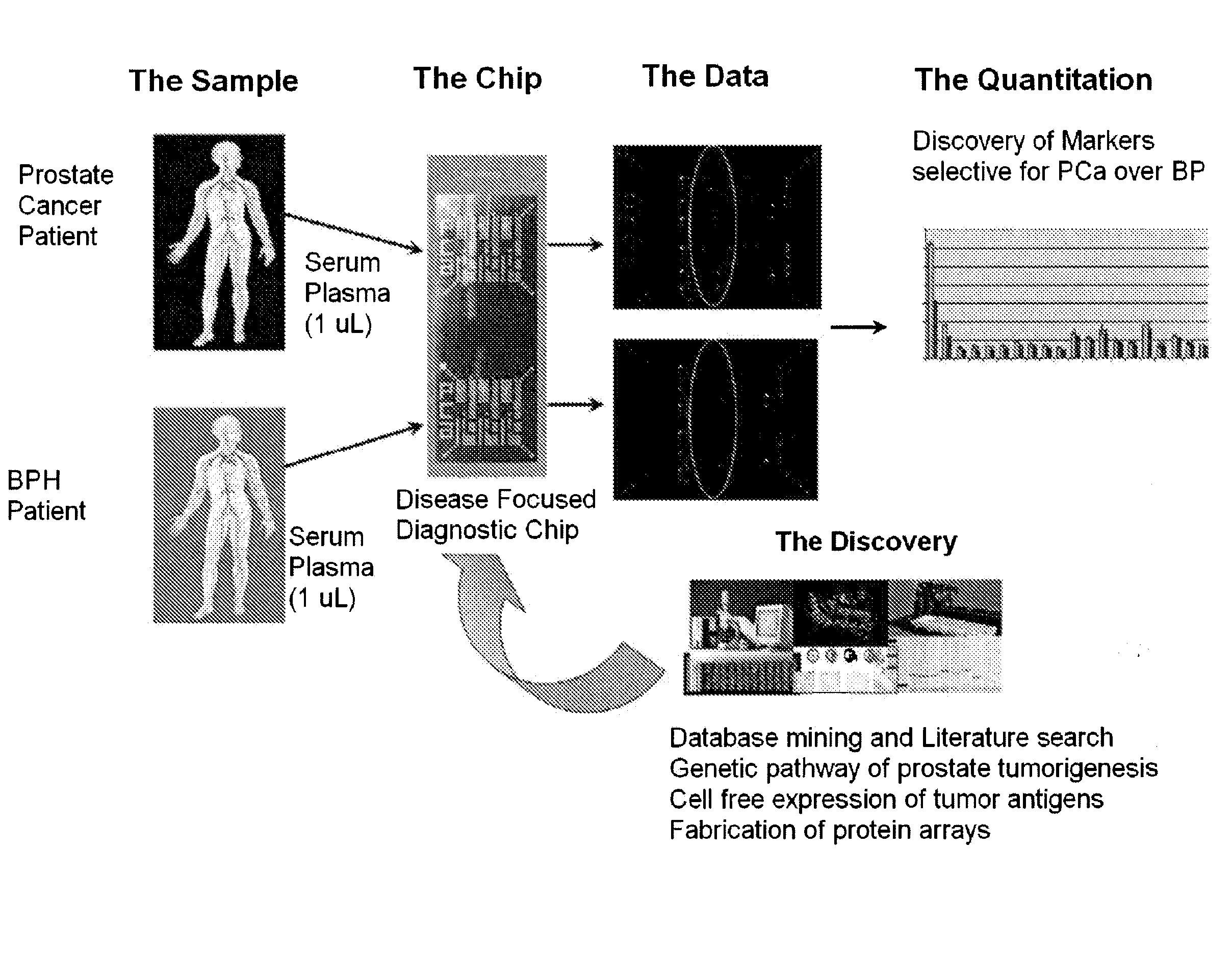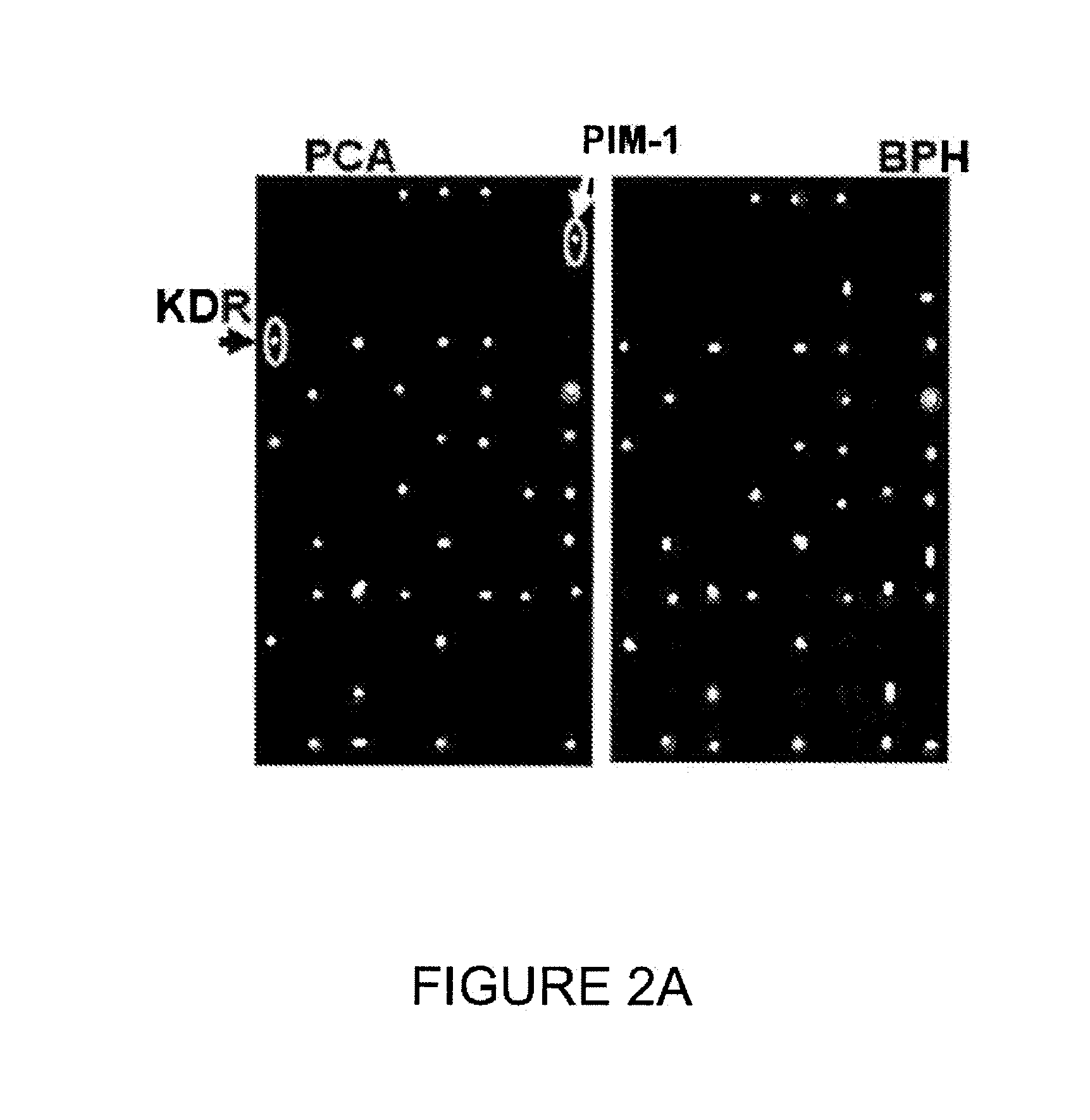Methods and kits for detecting prostate cancer biomarkers
a prostate cancer and biomarker technology, applied in the field of biomarkers associated with prostate cancer, can solve the problems of time and effort of a trained clinician, a false positive rate of almost 75%, and difficult early diagnosis of prostate cancer
- Summary
- Abstract
- Description
- Claims
- Application Information
AI Technical Summary
Benefits of technology
Problems solved by technology
Method used
Image
Examples
example 1
Test Protein Array for Diagnostic Autoantigens
[0201]Biomarker detection panels were sought having at least as high a sensitivity as the standard PSA test (80%), with higher specificity.
Experimental Design
[0202]A protein array was fabricated by spotting proteins on a planar nitrocellulose substrate. The overall design of the array is depicted in FIG. 1, which shows half of an array used to test for the diagnostic utility of the 108 antigens and 8 antibodies listed in Table 1. The antigens and antibodies were selected based on biological experiments, knowledge of biological pathways altered by cancer progression (including immunological pathways), analogy with other cancers, and literature searching to compile a list of proteins that were overexpressed, inappropriately expressed, or differentially modified or degraded in prostate cancer cells when compared with normal prostate cells.
[0203]Table 1 provides in the first column (“Marker”) the term used throughout this application for the...
example 2
Identification of Autoantigens Present in Prostate Cancer Sera on ProtoArrav™ Human Protein Array
[0215]The human Protoarray™ high content protein microarray from Invitrogen (Carlsbad, Calif.) was screened with sera using the methods provided in Example 1. A combination of single-patient sample and pooled-patient samples were utilized with these arrays. A total of 32 patient samples were screened (16 prostate cancer and 16 BPH) as well as series of pooled-patient samples representing high, medium, and low PSA values. All of this data was analyzed together to generate a list of approximately 98 candidate prostate cancer biomarkers (Table 11a).
[0216]The high density Protoarray™ microarray data was normalized using a Quantile Normalization method for all chips used. After normalization, the diagnostic value of individual markers was estimated by calculating all possible order M-statistics and their associated p-values. The order with the lowest p-value was selected for each marker, the ...
example 3
Autoantibodies Differentiating Prostate Cancer from Benign Prostatic Hyperplasia in Patients
[0218]Autoantibody profiling using a protein microarray chip containing 96 proteins thought to be associated with prostate cancer development was conducted using sera from 32 patients with prostate cancer and 32 patients with benign prostatic hyperplasia. The goal was to find biomarkers that are stable in blood, easily measured using approximately 1 μL of serum (or plasma), and that can differentiate true prostate cancer from the closely-related benign prostatic hyperplasia, the major weakness in the current, clinically used, PSA-based prostate cancer diagnostic test.
[0219]The scheme for testing chips with human sera from individuals with prostate cancer and BPH is provided in FIG. 5. Serum samples from individuals having prostate cancer and BPH were collected and contacted with a chip containing the possible target antigens. The resulting binding of target antigens to autoantibodies was quan...
PUM
 Login to View More
Login to View More Abstract
Description
Claims
Application Information
 Login to View More
Login to View More - R&D
- Intellectual Property
- Life Sciences
- Materials
- Tech Scout
- Unparalleled Data Quality
- Higher Quality Content
- 60% Fewer Hallucinations
Browse by: Latest US Patents, China's latest patents, Technical Efficacy Thesaurus, Application Domain, Technology Topic, Popular Technical Reports.
© 2025 PatSnap. All rights reserved.Legal|Privacy policy|Modern Slavery Act Transparency Statement|Sitemap|About US| Contact US: help@patsnap.com



